Portfolio: Attitudes, Values, and Indigenous Learning Experiences
VerifiedAdded on 2023/06/15
|6
|1462
|436
Portfolio
AI Summary
This portfolio critically reflects on attitudes and values towards Indigenous Peoples, emphasizing inclusivity and respect. It addresses potential biases and prejudices and explores how Indigenous education aligns with the professional role of advocating for children and families. The portfolio includes lesson planning using authentic learning experiences to teach children about Indigenous perspectives, promoting cultural appreciation and understanding. Strategies such as growing bush foods, ethical dilemma discussions, dialogue circles, and inviting Indigenous guest speakers are suggested to embed Indigenous perspectives into the education system. The aim is to move beyond token recognition during NAIDOC week towards a consistent integration of Indigenous culture and knowledge in schools. References are provided to support the discussion and proposed strategies.

Running head: Supporting Documentation 1
Supporting Documentation
by
Course:
Tutor:
University:
Department:
10 December 2017
Supporting Documentation
by
Course:
Tutor:
University:
Department:
10 December 2017
Paraphrase This Document
Need a fresh take? Get an instant paraphrase of this document with our AI Paraphraser
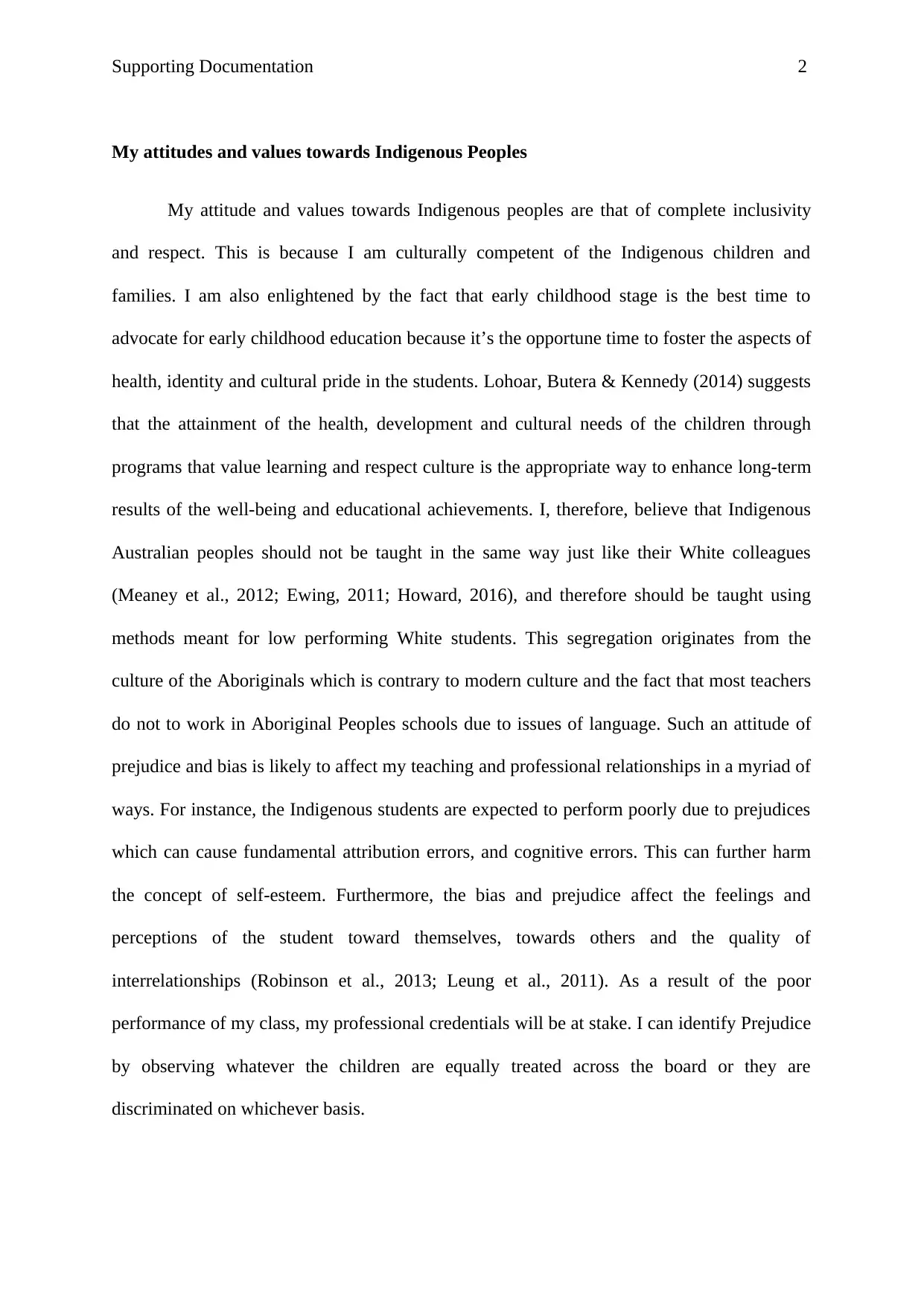
Supporting Documentation 2
My attitudes and values towards Indigenous Peoples
My attitude and values towards Indigenous peoples are that of complete inclusivity
and respect. This is because I am culturally competent of the Indigenous children and
families. I am also enlightened by the fact that early childhood stage is the best time to
advocate for early childhood education because it’s the opportune time to foster the aspects of
health, identity and cultural pride in the students. Lohoar, Butera & Kennedy (2014) suggests
that the attainment of the health, development and cultural needs of the children through
programs that value learning and respect culture is the appropriate way to enhance long-term
results of the well-being and educational achievements. I, therefore, believe that Indigenous
Australian peoples should not be taught in the same way just like their White colleagues
(Meaney et al., 2012; Ewing, 2011; Howard, 2016), and therefore should be taught using
methods meant for low performing White students. This segregation originates from the
culture of the Aboriginals which is contrary to modern culture and the fact that most teachers
do not to work in Aboriginal Peoples schools due to issues of language. Such an attitude of
prejudice and bias is likely to affect my teaching and professional relationships in a myriad of
ways. For instance, the Indigenous students are expected to perform poorly due to prejudices
which can cause fundamental attribution errors, and cognitive errors. This can further harm
the concept of self-esteem. Furthermore, the bias and prejudice affect the feelings and
perceptions of the student toward themselves, towards others and the quality of
interrelationships (Robinson et al., 2013; Leung et al., 2011). As a result of the poor
performance of my class, my professional credentials will be at stake. I can identify Prejudice
by observing whatever the children are equally treated across the board or they are
discriminated on whichever basis.
My attitudes and values towards Indigenous Peoples
My attitude and values towards Indigenous peoples are that of complete inclusivity
and respect. This is because I am culturally competent of the Indigenous children and
families. I am also enlightened by the fact that early childhood stage is the best time to
advocate for early childhood education because it’s the opportune time to foster the aspects of
health, identity and cultural pride in the students. Lohoar, Butera & Kennedy (2014) suggests
that the attainment of the health, development and cultural needs of the children through
programs that value learning and respect culture is the appropriate way to enhance long-term
results of the well-being and educational achievements. I, therefore, believe that Indigenous
Australian peoples should not be taught in the same way just like their White colleagues
(Meaney et al., 2012; Ewing, 2011; Howard, 2016), and therefore should be taught using
methods meant for low performing White students. This segregation originates from the
culture of the Aboriginals which is contrary to modern culture and the fact that most teachers
do not to work in Aboriginal Peoples schools due to issues of language. Such an attitude of
prejudice and bias is likely to affect my teaching and professional relationships in a myriad of
ways. For instance, the Indigenous students are expected to perform poorly due to prejudices
which can cause fundamental attribution errors, and cognitive errors. This can further harm
the concept of self-esteem. Furthermore, the bias and prejudice affect the feelings and
perceptions of the student toward themselves, towards others and the quality of
interrelationships (Robinson et al., 2013; Leung et al., 2011). As a result of the poor
performance of my class, my professional credentials will be at stake. I can identify Prejudice
by observing whatever the children are equally treated across the board or they are
discriminated on whichever basis.
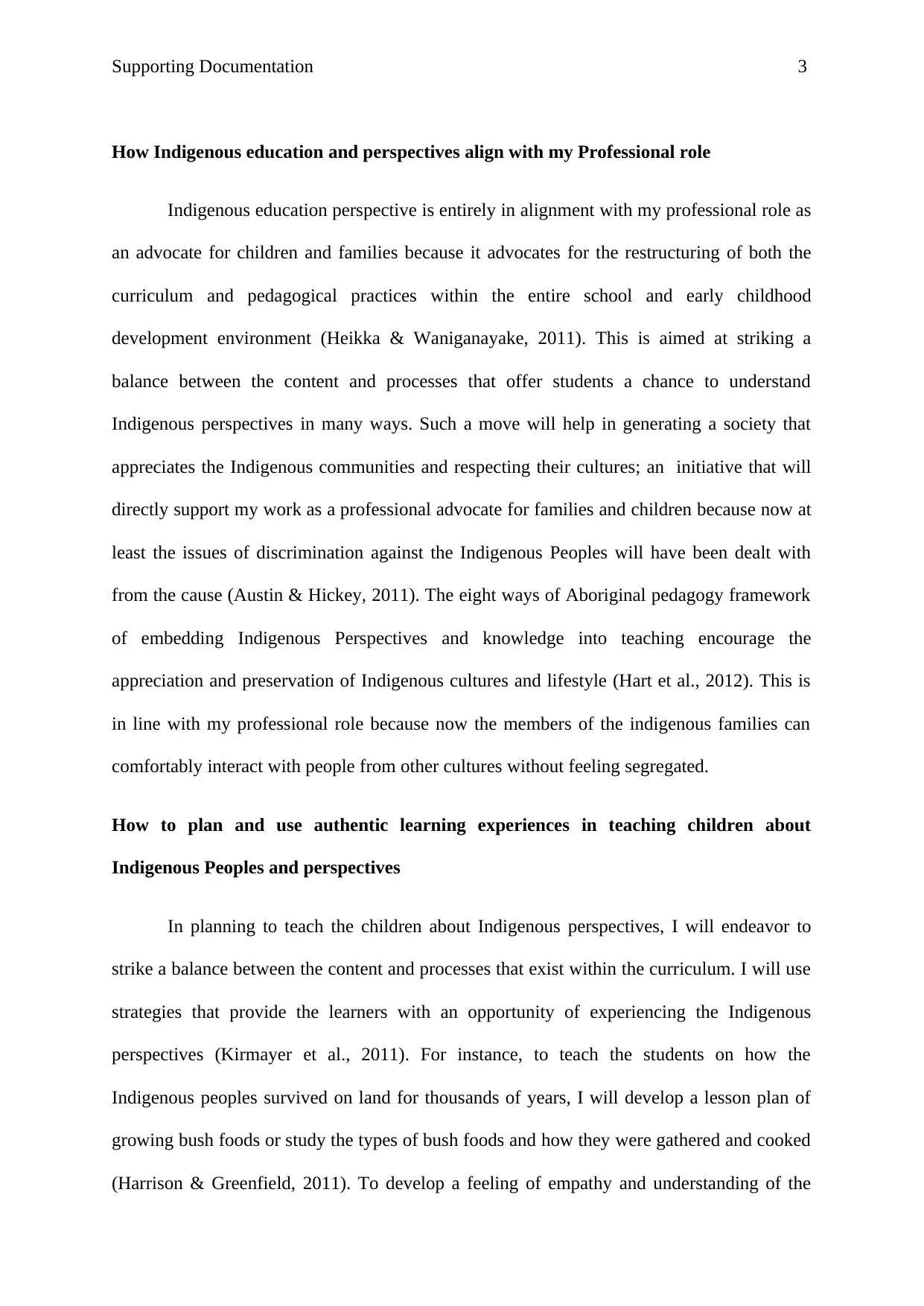
Supporting Documentation 3
How Indigenous education and perspectives align with my Professional role
Indigenous education perspective is entirely in alignment with my professional role as
an advocate for children and families because it advocates for the restructuring of both the
curriculum and pedagogical practices within the entire school and early childhood
development environment (Heikka & Waniganayake, 2011). This is aimed at striking a
balance between the content and processes that offer students a chance to understand
Indigenous perspectives in many ways. Such a move will help in generating a society that
appreciates the Indigenous communities and respecting their cultures; an initiative that will
directly support my work as a professional advocate for families and children because now at
least the issues of discrimination against the Indigenous Peoples will have been dealt with
from the cause (Austin & Hickey, 2011). The eight ways of Aboriginal pedagogy framework
of embedding Indigenous Perspectives and knowledge into teaching encourage the
appreciation and preservation of Indigenous cultures and lifestyle (Hart et al., 2012). This is
in line with my professional role because now the members of the indigenous families can
comfortably interact with people from other cultures without feeling segregated.
How to plan and use authentic learning experiences in teaching children about
Indigenous Peoples and perspectives
In planning to teach the children about Indigenous perspectives, I will endeavor to
strike a balance between the content and processes that exist within the curriculum. I will use
strategies that provide the learners with an opportunity of experiencing the Indigenous
perspectives (Kirmayer et al., 2011). For instance, to teach the students on how the
Indigenous peoples survived on land for thousands of years, I will develop a lesson plan of
growing bush foods or study the types of bush foods and how they were gathered and cooked
(Harrison & Greenfield, 2011). To develop a feeling of empathy and understanding of the
How Indigenous education and perspectives align with my Professional role
Indigenous education perspective is entirely in alignment with my professional role as
an advocate for children and families because it advocates for the restructuring of both the
curriculum and pedagogical practices within the entire school and early childhood
development environment (Heikka & Waniganayake, 2011). This is aimed at striking a
balance between the content and processes that offer students a chance to understand
Indigenous perspectives in many ways. Such a move will help in generating a society that
appreciates the Indigenous communities and respecting their cultures; an initiative that will
directly support my work as a professional advocate for families and children because now at
least the issues of discrimination against the Indigenous Peoples will have been dealt with
from the cause (Austin & Hickey, 2011). The eight ways of Aboriginal pedagogy framework
of embedding Indigenous Perspectives and knowledge into teaching encourage the
appreciation and preservation of Indigenous cultures and lifestyle (Hart et al., 2012). This is
in line with my professional role because now the members of the indigenous families can
comfortably interact with people from other cultures without feeling segregated.
How to plan and use authentic learning experiences in teaching children about
Indigenous Peoples and perspectives
In planning to teach the children about Indigenous perspectives, I will endeavor to
strike a balance between the content and processes that exist within the curriculum. I will use
strategies that provide the learners with an opportunity of experiencing the Indigenous
perspectives (Kirmayer et al., 2011). For instance, to teach the students on how the
Indigenous peoples survived on land for thousands of years, I will develop a lesson plan of
growing bush foods or study the types of bush foods and how they were gathered and cooked
(Harrison & Greenfield, 2011). To develop a feeling of empathy and understanding of the
⊘ This is a preview!⊘
Do you want full access?
Subscribe today to unlock all pages.

Trusted by 1+ million students worldwide
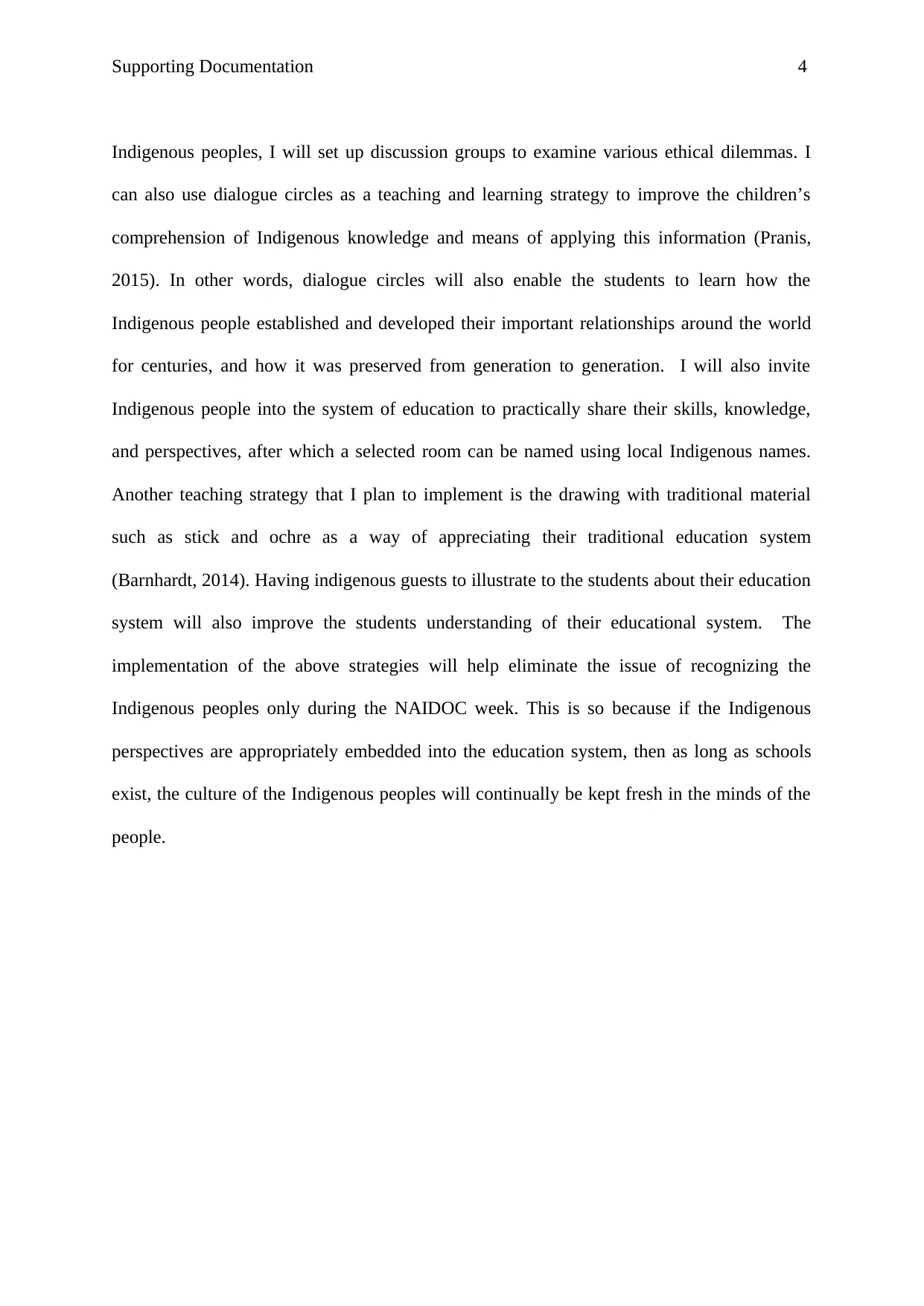
Supporting Documentation 4
Indigenous peoples, I will set up discussion groups to examine various ethical dilemmas. I
can also use dialogue circles as a teaching and learning strategy to improve the children’s
comprehension of Indigenous knowledge and means of applying this information (Pranis,
2015). In other words, dialogue circles will also enable the students to learn how the
Indigenous people established and developed their important relationships around the world
for centuries, and how it was preserved from generation to generation. I will also invite
Indigenous people into the system of education to practically share their skills, knowledge,
and perspectives, after which a selected room can be named using local Indigenous names.
Another teaching strategy that I plan to implement is the drawing with traditional material
such as stick and ochre as a way of appreciating their traditional education system
(Barnhardt, 2014). Having indigenous guests to illustrate to the students about their education
system will also improve the students understanding of their educational system. The
implementation of the above strategies will help eliminate the issue of recognizing the
Indigenous peoples only during the NAIDOC week. This is so because if the Indigenous
perspectives are appropriately embedded into the education system, then as long as schools
exist, the culture of the Indigenous peoples will continually be kept fresh in the minds of the
people.
Indigenous peoples, I will set up discussion groups to examine various ethical dilemmas. I
can also use dialogue circles as a teaching and learning strategy to improve the children’s
comprehension of Indigenous knowledge and means of applying this information (Pranis,
2015). In other words, dialogue circles will also enable the students to learn how the
Indigenous people established and developed their important relationships around the world
for centuries, and how it was preserved from generation to generation. I will also invite
Indigenous people into the system of education to practically share their skills, knowledge,
and perspectives, after which a selected room can be named using local Indigenous names.
Another teaching strategy that I plan to implement is the drawing with traditional material
such as stick and ochre as a way of appreciating their traditional education system
(Barnhardt, 2014). Having indigenous guests to illustrate to the students about their education
system will also improve the students understanding of their educational system. The
implementation of the above strategies will help eliminate the issue of recognizing the
Indigenous peoples only during the NAIDOC week. This is so because if the Indigenous
perspectives are appropriately embedded into the education system, then as long as schools
exist, the culture of the Indigenous peoples will continually be kept fresh in the minds of the
people.
Paraphrase This Document
Need a fresh take? Get an instant paraphrase of this document with our AI Paraphraser
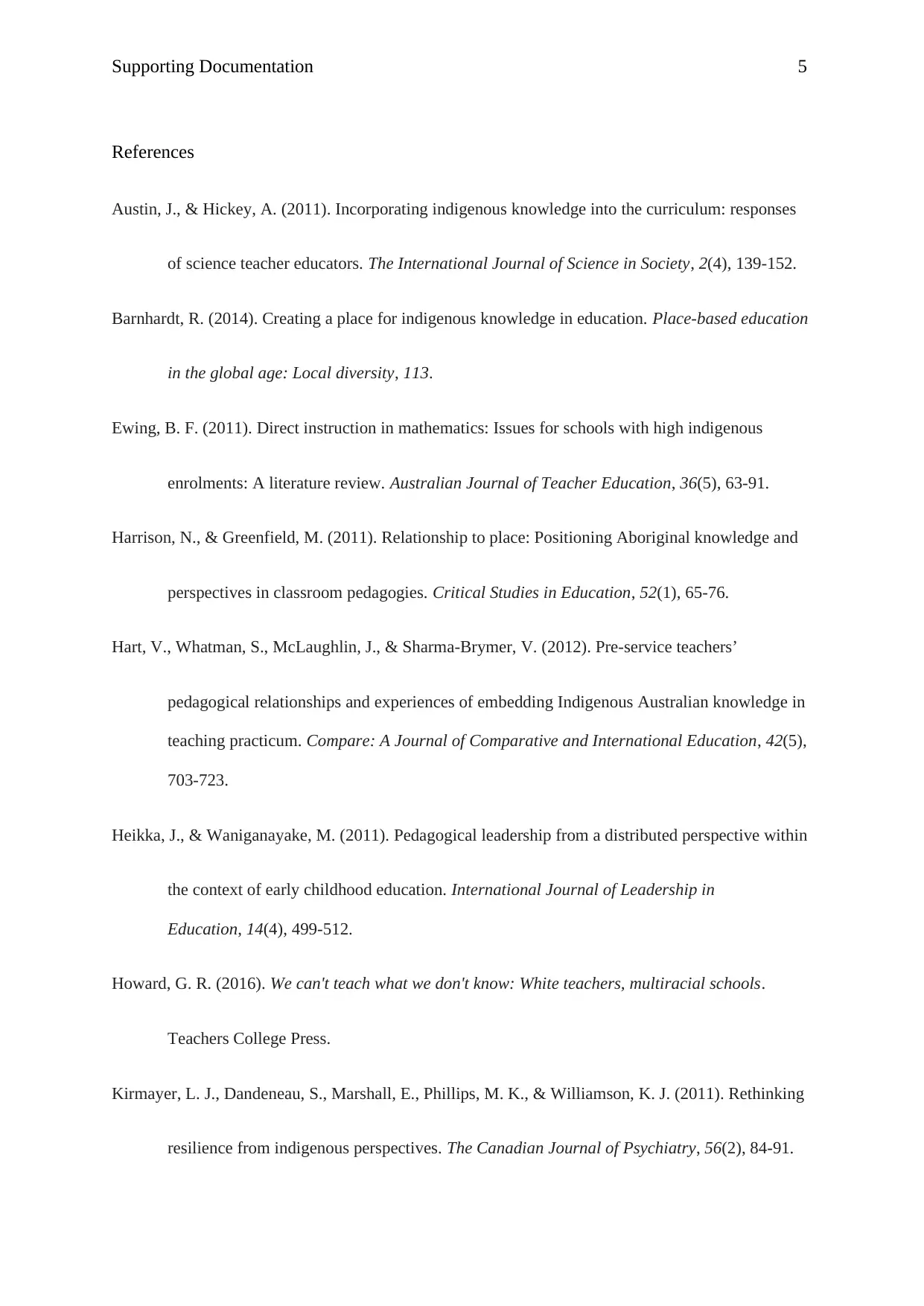
Supporting Documentation 5
References
Austin, J., & Hickey, A. (2011). Incorporating indigenous knowledge into the curriculum: responses
of science teacher educators. The International Journal of Science in Society, 2(4), 139-152.
Barnhardt, R. (2014). Creating a place for indigenous knowledge in education. Place-based education
in the global age: Local diversity, 113.
Ewing, B. F. (2011). Direct instruction in mathematics: Issues for schools with high indigenous
enrolments: A literature review. Australian Journal of Teacher Education, 36(5), 63-91.
Harrison, N., & Greenfield, M. (2011). Relationship to place: Positioning Aboriginal knowledge and
perspectives in classroom pedagogies. Critical Studies in Education, 52(1), 65-76.
Hart, V., Whatman, S., McLaughlin, J., & Sharma-Brymer, V. (2012). Pre-service teachers’
pedagogical relationships and experiences of embedding Indigenous Australian knowledge in
teaching practicum. Compare: A Journal of Comparative and International Education, 42(5),
703-723.
Heikka, J., & Waniganayake, M. (2011). Pedagogical leadership from a distributed perspective within
the context of early childhood education. International Journal of Leadership in
Education, 14(4), 499-512.
Howard, G. R. (2016). We can't teach what we don't know: White teachers, multiracial schools.
Teachers College Press.
Kirmayer, L. J., Dandeneau, S., Marshall, E., Phillips, M. K., & Williamson, K. J. (2011). Rethinking
resilience from indigenous perspectives. The Canadian Journal of Psychiatry, 56(2), 84-91.
References
Austin, J., & Hickey, A. (2011). Incorporating indigenous knowledge into the curriculum: responses
of science teacher educators. The International Journal of Science in Society, 2(4), 139-152.
Barnhardt, R. (2014). Creating a place for indigenous knowledge in education. Place-based education
in the global age: Local diversity, 113.
Ewing, B. F. (2011). Direct instruction in mathematics: Issues for schools with high indigenous
enrolments: A literature review. Australian Journal of Teacher Education, 36(5), 63-91.
Harrison, N., & Greenfield, M. (2011). Relationship to place: Positioning Aboriginal knowledge and
perspectives in classroom pedagogies. Critical Studies in Education, 52(1), 65-76.
Hart, V., Whatman, S., McLaughlin, J., & Sharma-Brymer, V. (2012). Pre-service teachers’
pedagogical relationships and experiences of embedding Indigenous Australian knowledge in
teaching practicum. Compare: A Journal of Comparative and International Education, 42(5),
703-723.
Heikka, J., & Waniganayake, M. (2011). Pedagogical leadership from a distributed perspective within
the context of early childhood education. International Journal of Leadership in
Education, 14(4), 499-512.
Howard, G. R. (2016). We can't teach what we don't know: White teachers, multiracial schools.
Teachers College Press.
Kirmayer, L. J., Dandeneau, S., Marshall, E., Phillips, M. K., & Williamson, K. J. (2011). Rethinking
resilience from indigenous perspectives. The Canadian Journal of Psychiatry, 56(2), 84-91.
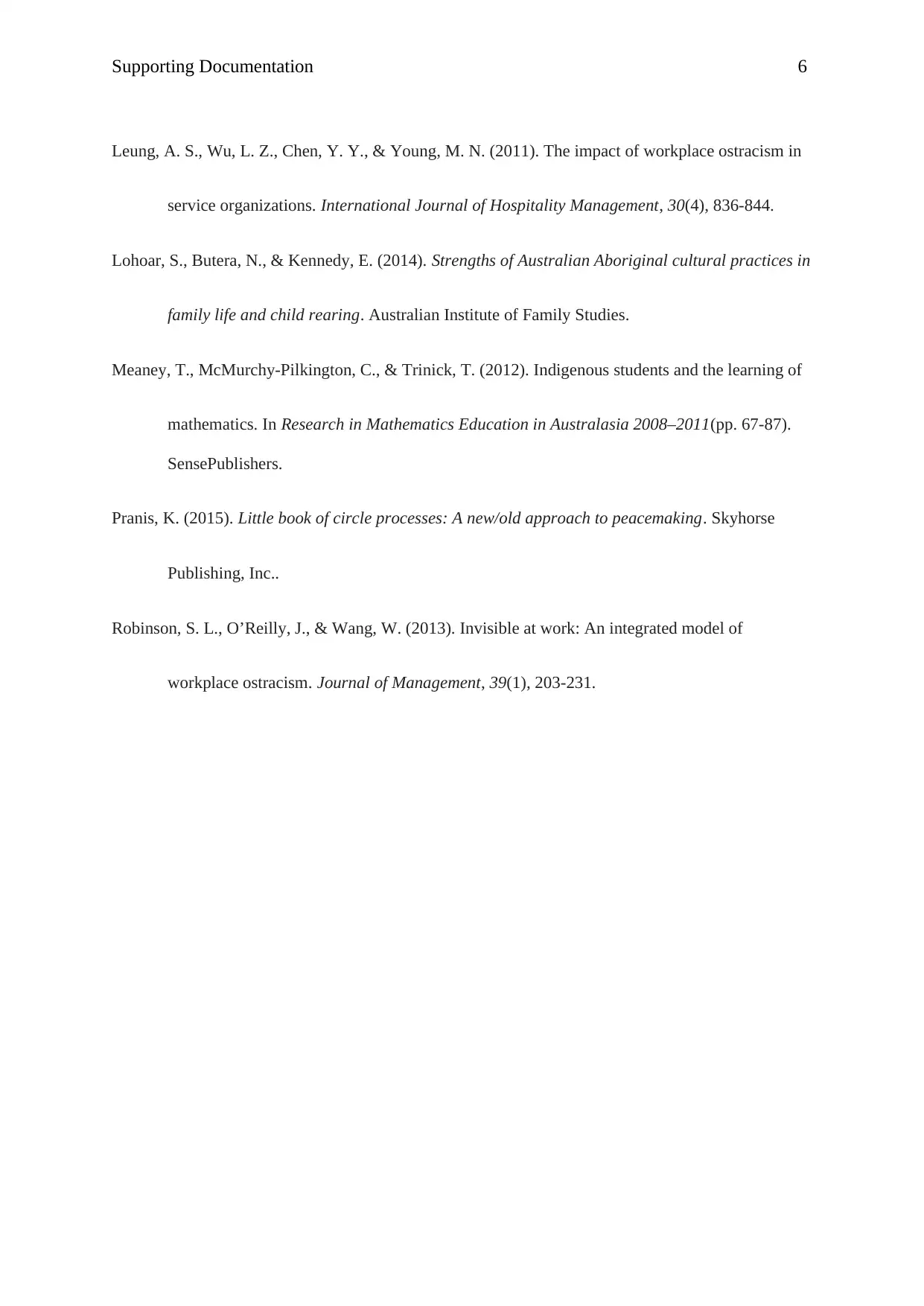
Supporting Documentation 6
Leung, A. S., Wu, L. Z., Chen, Y. Y., & Young, M. N. (2011). The impact of workplace ostracism in
service organizations. International Journal of Hospitality Management, 30(4), 836-844.
Lohoar, S., Butera, N., & Kennedy, E. (2014). Strengths of Australian Aboriginal cultural practices in
family life and child rearing. Australian Institute of Family Studies.
Meaney, T., McMurchy-Pilkington, C., & Trinick, T. (2012). Indigenous students and the learning of
mathematics. In Research in Mathematics Education in Australasia 2008–2011(pp. 67-87).
SensePublishers.
Pranis, K. (2015). Little book of circle processes: A new/old approach to peacemaking. Skyhorse
Publishing, Inc..
Robinson, S. L., O’Reilly, J., & Wang, W. (2013). Invisible at work: An integrated model of
workplace ostracism. Journal of Management, 39(1), 203-231.
Leung, A. S., Wu, L. Z., Chen, Y. Y., & Young, M. N. (2011). The impact of workplace ostracism in
service organizations. International Journal of Hospitality Management, 30(4), 836-844.
Lohoar, S., Butera, N., & Kennedy, E. (2014). Strengths of Australian Aboriginal cultural practices in
family life and child rearing. Australian Institute of Family Studies.
Meaney, T., McMurchy-Pilkington, C., & Trinick, T. (2012). Indigenous students and the learning of
mathematics. In Research in Mathematics Education in Australasia 2008–2011(pp. 67-87).
SensePublishers.
Pranis, K. (2015). Little book of circle processes: A new/old approach to peacemaking. Skyhorse
Publishing, Inc..
Robinson, S. L., O’Reilly, J., & Wang, W. (2013). Invisible at work: An integrated model of
workplace ostracism. Journal of Management, 39(1), 203-231.
⊘ This is a preview!⊘
Do you want full access?
Subscribe today to unlock all pages.

Trusted by 1+ million students worldwide
1 out of 6
Related Documents
Your All-in-One AI-Powered Toolkit for Academic Success.
+13062052269
info@desklib.com
Available 24*7 on WhatsApp / Email
![[object Object]](/_next/static/media/star-bottom.7253800d.svg)
Unlock your academic potential
Copyright © 2020–2025 A2Z Services. All Rights Reserved. Developed and managed by ZUCOL.


